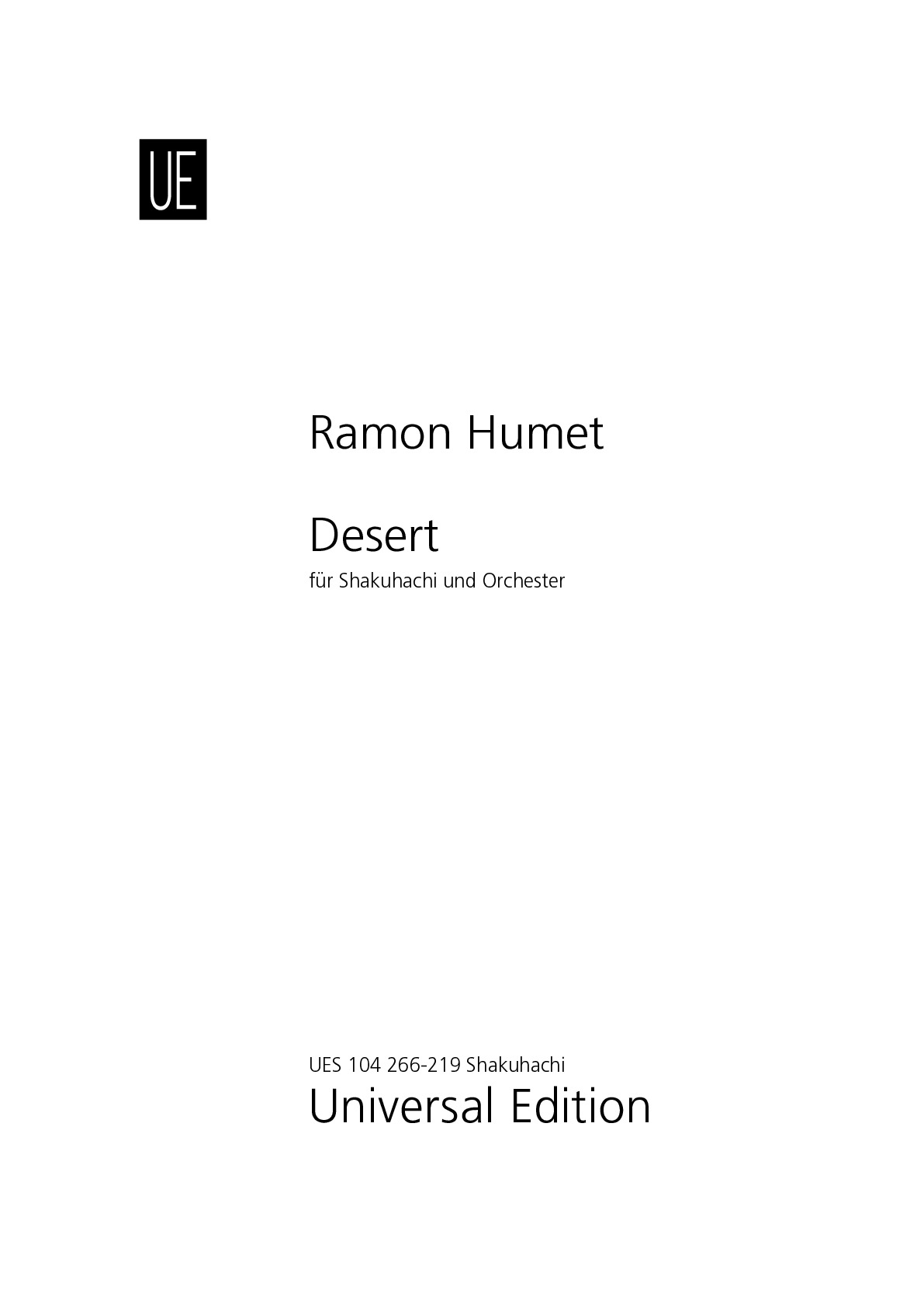.png)
Digital edition
immediately available as PDF
€14.95
Payments:
Shipping:
Ramon Humet
Shakuhachi (Desert)
UES104266-219
Type: Solostimme(n)
Format: 210 x 297 mm
Pages: 24
Digital edition
immediately available as PDF
€14.95
Payments:
Shipping:
Audio preview
Description
Desert is a concerto for shakuhachi and orchestra commissioned by the National Orchestra of Spain. It was premiered on 14, 15 and 16 June 2019 at the National Music Auditorium in Madrid with soloist Horacio Curti, conducted by Paolo Bressan, in commemoration of the bicentenary of the Prado Museum.
The desert is the ecosystem in which anchorites lived out a life of prayer in communion with the Universe. A barren, open space of wide horizons, where solitude was a source of knowledge and encouraged the loosening of earthly ties. The engraving Anchorite by the artist Maria Fortuny i Marsal, (b. Reus 1838, d. Rome 1874), presents a powerful image of nature beneath a sky that presages an imminent storm, the hermit seated in the middle distance with his back to the viewer, humbly contemplating the landscape before him. This masterpiece, which forms part of the collection of the Prado Museum, is one of the sources of inspiration for Desert, a piece for shakuhachi and orchestra, written in celebration of the art gallery’s bicentenary.
There is something rustic about a life of prayer in the desert which connects directly to the shakuhachi, the Japanese bamboo flute that was played by pilgrim monks of the Zen Buddhist Fuke sect. An austere instrument, without artifice nor any added mechanism –just five holes and a perfectly carved mouthpiece–, the simplicity of its construction provides a range of sound colours of extraordinarily rich nuances: full, rounded timbres, blowing sounds, a certain non-harmonicity of spectrum, great flexibility in the modification of high notes with remarkable possibilities for glissandi, and a fascinating traditional corpus –the koten honkyoku– of astonishing melodic beauty.
Two utterly different musical worlds, the symphonic orchestra and the shakuhachi, converge in this work. The Western instruments achieve significant rhythmic precision of performance. The shakuhachi, on the other hand, and specifically the honkyoku genre, uses less measured parameters, such as ma –a concept that can be translated as “the space a sound needs to be able to exist”–, an idea rooted in traditional Japanese arts and related to a global (non-lineal) vision of time. Thus, the composition of the solo part employs the technique of space notation, which is sympathetic to the philosophic concept of time of the honkyoku, while the orchestral part is articulated by means of standard Western metre.
Far from wanting to add colour to silence, the work can be compared to the verses of Jacint Verdaguer in Plus Ultra: “...i aon tu veus lo desert / eixams de mons formiguegen.”, (but where you see desert / swarms of worlds teem). An arsenal of varied musical elements, which represent the immensity of the desert –dialectical struggle between soloist and orchestra, acoustic magma, sharp cubist edges, gradual loss of pulsation, circular birdsong, harmonic scraps, irregular iteration of a repetitive motif, and so on– are counterposed to the emptiness of the shakuhachi’s naked sound. The duality between the musical phenomena of the orchestra and the stripped-back quality of the soloist gradually evolves, until they dissolve in the final, innocent-sounding motif, which brings together and unites the two different world views.
The orchestral colour assumes different characteristics depending on the presence or absence of certain instruments. The presence of two light penetrating piccolos reinforces the melodic gestures, especially in the sound passages with birds. The absence of oboes and C flutes reduces the specific weight of the wood section, thereby giving greater importance to the soloist. The absence of trumpets and timpani permits a general timbre that is very different from the conventional sound of the classical orchestra; reinforcing the use of trombones –of a richer timbre– and two different sized bass drums –deep voiced, and famous for their ability to modulate timbre in the pianissimo range. The use of wooden percussion instruments –log drum, temple block and wood block– is also significant, creating a counterpoint of energetic articulation that complements the penetrating phrasing of the shakuhachi and conserves a rustic, atavistic and primitive quality.
The cadenza –which is improvised, although a written model is available– constitutes the culminating point of the two worlds, that of the desert and that of the hermit; this then leads into the conclusion of the work, where a minimalist theme repeats itself in a circular fashion with minimal metrical variations, alternating with a shadow of sound from the bamboo flute. The repetition of the theme dissolves into the lone voice of the shakuhachi, exhaling the final notes in its higher register to become air, silence.
Desert was commissioned by the National Orchestra of Spain, to be premiered on 14, 15 and 16 June 2019 at the National Music Auditorium in Madrid with soloist Horacio Curti, conducted by Paolo Bressan, in commemoration of the bicentenary of the Prado Museum.
More information
Type: Solostimme(n)
Format: 210 x 297 mm
Pages: 24

